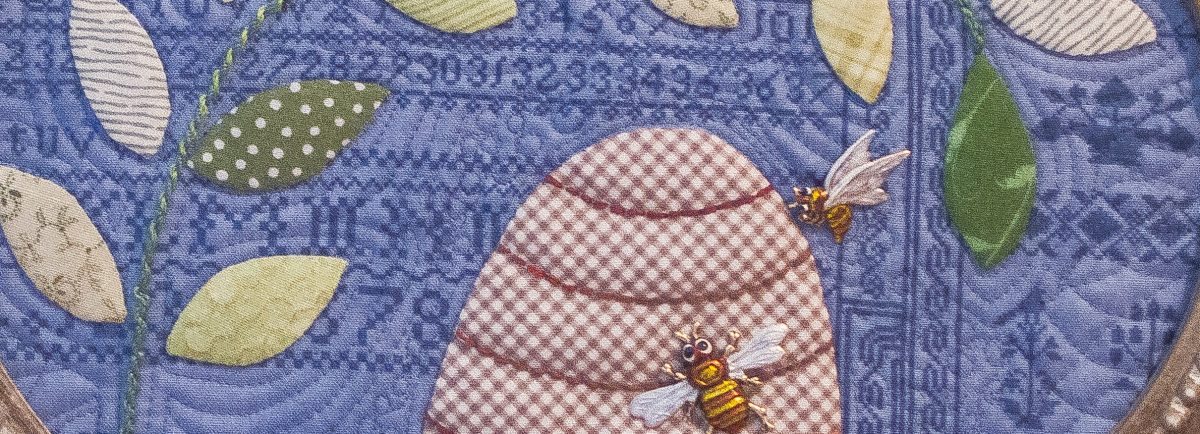 It was a gray day when we recently visited Fairhope, Alabama, but I had a bit of color in my purse. Early in my quilting adventures (2003, I think), we visited Fairhope and I saw a log cabin quilt made from reproduction feedsack fabrics. I came home and started sewing.
It was a gray day when we recently visited Fairhope, Alabama, but I had a bit of color in my purse. Early in my quilting adventures (2003, I think), we visited Fairhope and I saw a log cabin quilt made from reproduction feedsack fabrics. I came home and started sewing.
 When we headed to Fairhope last week, I rolled the little quilt and tucked it into my purse just in case there were any photo ops.
When we headed to Fairhope last week, I rolled the little quilt and tucked it into my purse just in case there were any photo ops.
 The skies were heavy, so I stopped at the first picket fence with a color-coordinated house behind it, and snapped this view.
The skies were heavy, so I stopped at the first picket fence with a color-coordinated house behind it, and snapped this view.
 In a couple of shops, I saw welcoming vignettes and store owners graciously let me drape the fabric about their merchandise. Its amazing what a crazy old woman can get away with if she bothers to ask.
In a couple of shops, I saw welcoming vignettes and store owners graciously let me drape the fabric about their merchandise. Its amazing what a crazy old woman can get away with if she bothers to ask.
 In a tee-shirt shop, I was amazed that they had laid out a display of shirts in just these feedsack colors!
In a tee-shirt shop, I was amazed that they had laid out a display of shirts in just these feedsack colors!
 And then, Sailor sauntered by and plopped down for a nap. He was kind enough to model the quilt, creating a unique spot for Fairhope Feedsacks to rest.
And then, Sailor sauntered by and plopped down for a nap. He was kind enough to model the quilt, creating a unique spot for Fairhope Feedsacks to rest.
 At the pier, pilings and tree roots served as quilt racks.
At the pier, pilings and tree roots served as quilt racks.
 And, at a candy store, more fences, porch railings, an old dresser, and even a baby carriage, a blue baby carriage, gave the little bit of a quilt a place to perch.
And, at a candy store, more fences, porch railings, an old dresser, and even a baby carriage, a blue baby carriage, gave the little bit of a quilt a place to perch.
 Now Im looking for places to take some other small quilts. I love making the little ones. And since Im doing it for fun, who cares what size it is? I know a lot of people think a quilt has to cover a bed. Im so glad they are wrong!
Now Im looking for places to take some other small quilts. I love making the little ones. And since Im doing it for fun, who cares what size it is? I know a lot of people think a quilt has to cover a bed. Im so glad they are wrong!
 Fairhope Feedsacks measures 19 x 24 . The logs finish at 3/4 wide. I probably used Dream cotton request batting and cotton thread.
Fairhope Feedsacks measures 19 x 24 . The logs finish at 3/4 wide. I probably used Dream cotton request batting and cotton thread.
Lessons learned from this quilt:
Washing a quilt gives it a softened aged look instantly.
I personally dont like the same fabrics used in the same position in a log cabin (thats what I did here, giving the double dose of turquoise every time the blocks meet). I like the colors to be more random, scrappier.
 The result, this little piece, was one of my first attempts at free motion quilting. I used a variegated thread and a simple meandering stitched path. Its not complicated, Its not a competitive piece, but the little quilt is pleasing to hang about the house
or on fence posts, or at the beach, or on a cooperative doggie.
The result, this little piece, was one of my first attempts at free motion quilting. I used a variegated thread and a simple meandering stitched path. Its not complicated, Its not a competitive piece, but the little quilt is pleasing to hang about the house
or on fence posts, or at the beach, or on a cooperative doggie.
 Here is a photo of Fairhope Feedsacks at home, atop the clock in the breakfast room where it hung out all summer with a compatibly colored rooster.
Here is a photo of Fairhope Feedsacks at home, atop the clock in the breakfast room where it hung out all summer with a compatibly colored rooster.







































































































